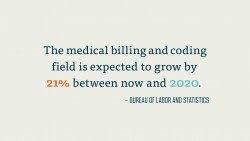Medical billing and coding are two closely related aspects of the modern health care industry. Both practices are involved in the immensely important reimbursement cycle, which ensures that health care providers are paid for the services they perform.
For the sake of simplicity, let’s divide the two at the moment and look at them as separate pieces of a larger process.
We’ll begin with medical coding.
FEATURED ONLINE MEDICAL CODING PROGRAMS
1.02: What is Medical Billing and Coding?
In this video, we’ll look at the most basic elements of the billing and coding process, and show how to interact with healthcare providers, patients, and insurance payers.
Medical Coding
Medical coding, at it’s most basic, is a little like translation. It’s the coder’s job to take something that’s written one way (a doctor’s diagnosis, for example, or a prescription for a certain medication) and translate it as accurately as possible into a numeric or alphanumeric code. For every injury, diagnosis, and medical procedure, there is a corresponding code.
There are thousands and thousands of codes for medical procedures, outpatient procedures, and diagnoses. Let’s start with a quick example of medical coding in action.
A patient walks into a doctor’s office with a hacking cough, high production of mucus or sputum, and a fever. A nurse asks the patient their symptoms and performs some initial tests, and then the doctor examines the patient and diagnoses bronchitis. The doctor then prescribes medication to the patient.
Every part of this visit is recorded by the doctor or someone in the healthcare provider’s office. It’s the medical coder’s job to translate every bit of relevant information in that patient’s visit into numeric and alphanumeric codes, which can then be used in the billing process.
There are a number of sets and subsets of code that a medical coder must be familiar with, but for this example we’ll focus on two: the International Classification of Diseases, or ICD, codes, which correspond to a patient’s injury or sickness, and Current Procedure Terminology, or CPT, codes, which relate to what functions and services the healthcare provider performed on or for the patient. These codes act as the universal language between doctors, hospitals, insurance companies, insurance clearinghouses, government agencies, and other health-specific organizations.
The coder reads the healthcare provider’s report of the patient’s visit and then translates each bit of information into a code. There’s a specific code for what kind of visit this is, the symptoms that patient is showing, what tests the doctor does, and what the doctor diagnoses the patient with.
Every code set has its own set of guidelines and rules. Certain codes, like ones that signify a pre-existing condition, need to be placed in a very particular order. Coding accurately and within the specific guidelines for each code will affect the status of a claim.
The coding process ends when the medical coder enters the appropriate codes into a form or software program. Once the report is coded, it’s passed on to the medical biller.
FEATURED ONLINE MEDICAL CODING PROGRAMS
Medical Billing
On one level, medical billing is as simple as it sounds: medical billers take the information from the medical coder and make a bill for the insurance company, called a claim.
Of course, as with everything related to the health care system, this process isn’t as simple as it seems.
To get a better look at medical billing, let’s rewind the example we used earlier. Our same patient has a cough, a fever, and is producing lots of mucus. This patient calls the doctor and schedules an appointment. It’s here that the medical billing process begins.
The medical biller takes the codes, which show what kind of visit this is, what symptoms the patient shows, what the doctor’s diagnosis is, and what the doctor prescribes, and creates a claim out of these using a form or a type of software. The biller then sends this claim to the insurance company, which evaluates and returns it. The biller then evaluates this returned claim and figures out how much of the bill the patient owes, after the insurance is taken out.
If our bronchitis-afflicted patient has an insurance plan that covers this type of visit and the treatment for this condition, their bill will be relatively low. The patient may have a co-pay, or have some other form of arrangement with their insurance company. The biller takes all of this into account and creates an accurate bill, which is then passed on to the patient.
In the case of a patient being delinquent or unwilling to pay the bill, the medical biller may have to hire a collections agency in order to ensure that the healthcare provider is properly compensated.
The medical biller, therefore, acts as a sort of waypoint between patients, healthcare providers, and insurance companies. You can think of the biller, like the coder, as a sort of translator—where the coder translates medical procedures into code, the biller translates codes into a financial report. The biller has a number of other responsibilities, but for now you should simply know that the biller is in charge of making sure the healthcare provider is properly reimbursed for their services.





